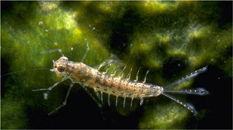Mayfly-Mimicking Sensor to Replace Proverbial Canary in the Coal Mine |
|
FOR IMMEDIATE RELEASE CONTACT:
COLLEGE PARK, Md.—Security, health and safety sensors in coal mines, buildings or underground public transit areas where air or water does not readily flow may one day be improved by research on young mayflies at the University of Maryland's A. James Clark School of Engineering. Mechanical engineers Ken Kiger and Elias Balaras and entomologist Jeffrey Shultz at the University of Maryland have identified a biological mechanism in the young mayflies that could enable sensors in stagnant environments to make air or water flow past them so they can detect harmful substances. Young aquatic mayflies, or "nymphs," enhance their respiration using gills. They do this by creating a flow of fresh water with the help of seven pairs of nearby gill plates that flap like a Venetian blind. The flow of fresh water is generated by the plate’s motion, directing water to the mayfly’s gills as efficiently as possible. "By duplicating the action of the mayfly gill plates in a tiny robotic device, we hope to create a flow of air or water to sensors in stagnant environments, so they can operate more effectively," Kiger said. Working with the University’s Department of Entomology, Kiger, an associate professor of mechanical engineering, is exploring how the mayfly’s gill plates work, and how to make a robotic version. The researchers are currently duplicating and measuring the gill plate movement in a virtual computer model. The researchers are also taking a closer look into something that scientists have known for a long time: at a sufficiently small size, an object is less affected by inertia than it is by the thickness (viscosity) of the water it is travelling through. For example, consider a canoe in comparison to a mayfly. As it travels through the water, the canoe produces a current, which will continue to ripple through the water for some time after the canoe moves on. This is an effect of the water's inertia. The opposite is true for the tiny mayfly nymph, which is so small that the thickness (viscosity) of the water stops such a current almost as soon as the gill plates stop. Once the mayfly grows to a certain size though, it is capable of creating an inertial effect, or ripples, of its own. Its gills respond accordingly, which is a trait the researchers hope to replicate in their sensors. "Mayfly sizes are right at the point where issues of viscosity and inertia switch in importance," Kiger said. "Depending on whether the weight or the thickness of the water is influencing its movement, the mayfly switches the way it pumps water to its gills." The current trend in sensor technology is to strive for smaller and more compact devices to enhance their portability and reduce power consumption. As a result of this trend, traditional technology sensors will run into the same difficulty as experienced by the mayfly as the sensors reach smaller and smaller sizes: eventually a transition will occur where inertial flow mechanisms will become ineffective. Studying how the mayfly deals with this transition can give us insight into how to better develop equivalent engineered sensors. The next step will be to construct a tiny artificial micro-robot that can reproduce the switchable gill action of the mayfly nymph. Such a mechanism could be installed in sensors intended to detect unhealthy air in otherwise stagnant areas, such as in subway stations or mines. If a miniature set of robotic mayfly gill plates can move air over a sensor, potentially harmful substances can be detected faster – and no canaries would be harmed in the process. This work is been supported by the National Science Foundation. Entomology graduate student Andrew Sensenig also contributed to this research. Related Links: About the A. James Clark School of Engineering The Clark School's graduate programs are collectively the fastest rising in the nation. In U.S. News & World Report's annual rating of graduate programs, the school is 17th among public and private programs nationally, 11th among public programs nationally and first among public programs in the mid-Atlantic region. The School offers 13 graduate programs and 12 undergraduate programs, including degree and certification programs tailored for working professionals. The school is home to one of the most vibrant research programs in the country. With major emphasis in key areas such as communications and networking, nanotechnology, bioengineering, reliability engineering, project management, intelligent transportation systems and space robotics, as well as electronic packaging and smart small systems and materials, the Clark School is leading the way toward the next generations of engineering advances. Visit the Clark School homepage at www.eng.umd.edu.
|
|
||||||||||||||





